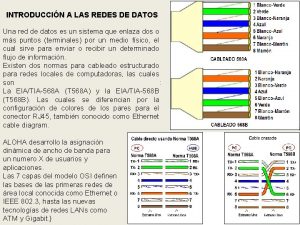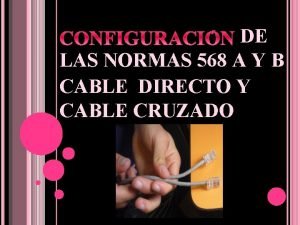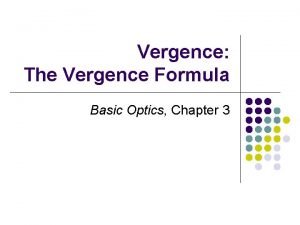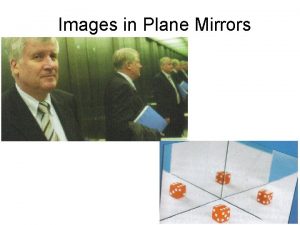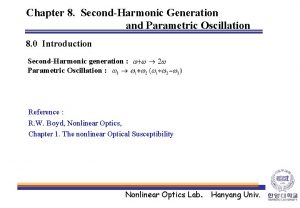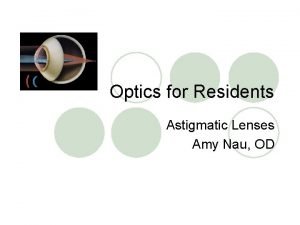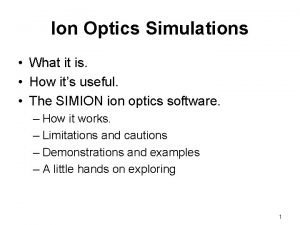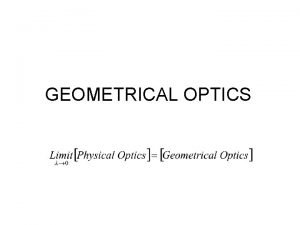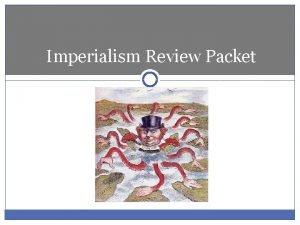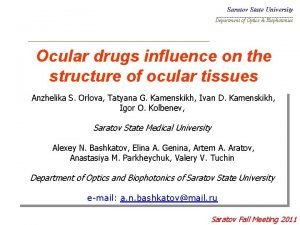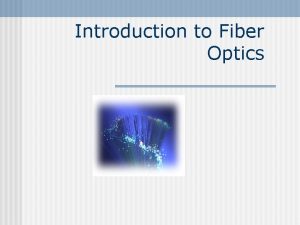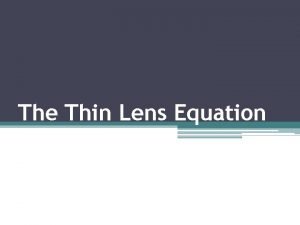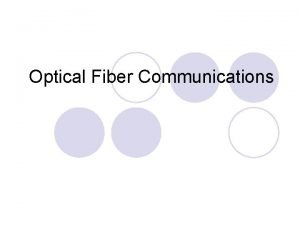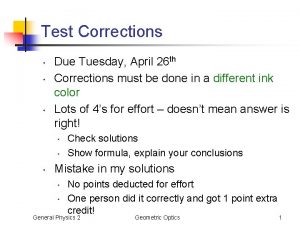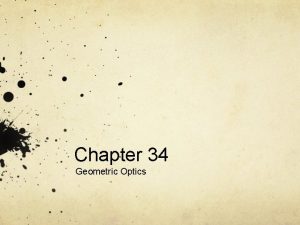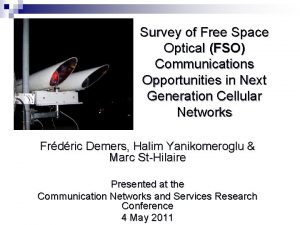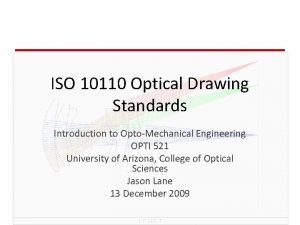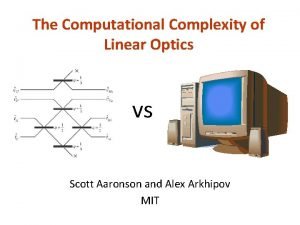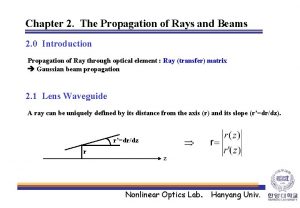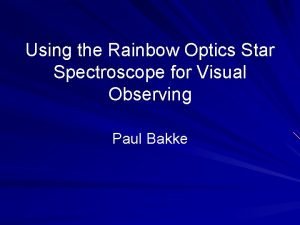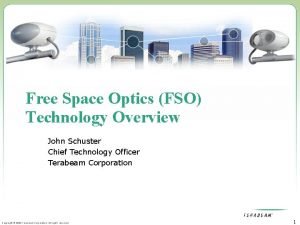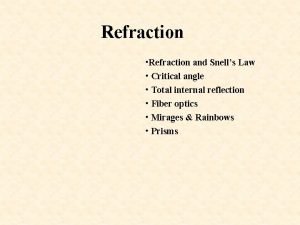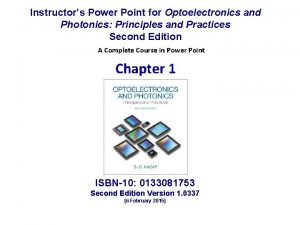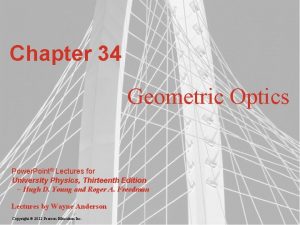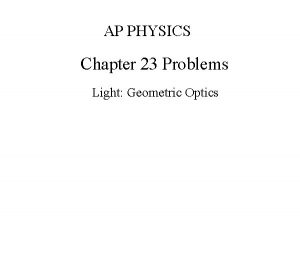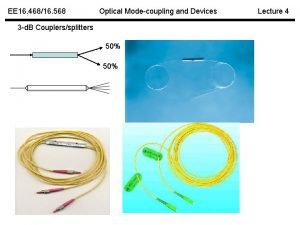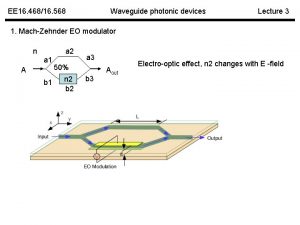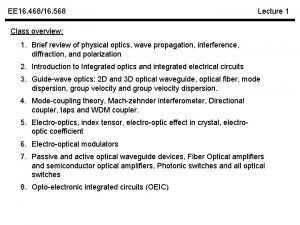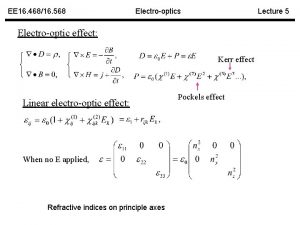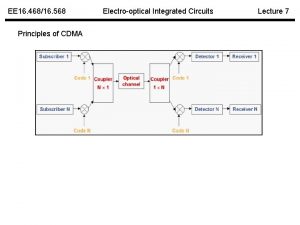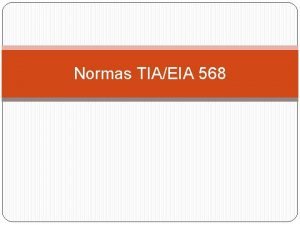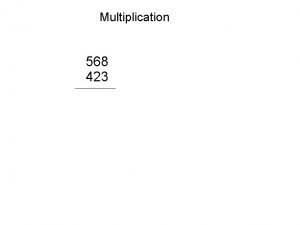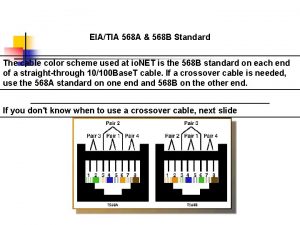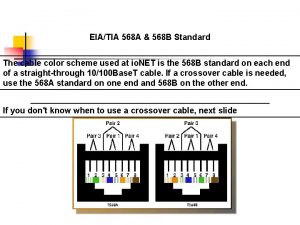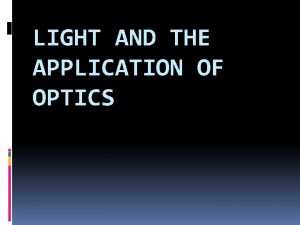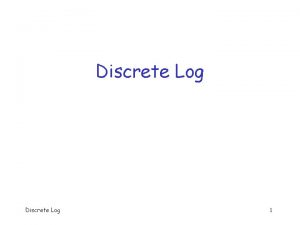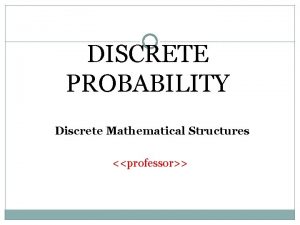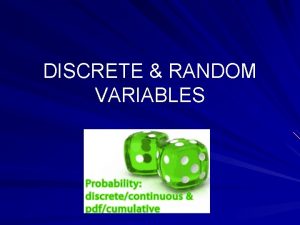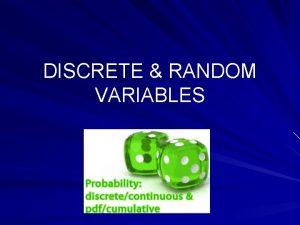EE 16 46816 568 Discrete optics v s






































- Slides: 38

EE 16. 468/16. 568 Discrete optics v. s. Integrated optics Discrete optics: • Mirrors, lens, mechanical mounts • bulky • labor intensive alignment • ray optics • environment sensitive Integrated optics: • Waveguide • Bendable, portable • Free-of-alignment • wave optics • robust • more functionalities Lecture 2

EE 16. 468/16. 568 Discrete optics v. s. Integrated optics Applications of Integrated optics: • Transmitters and receivers, transceivers • All optical signal processing • Ultra-high speed communications (100 Gbit/s), optical packet switching • RF spectrum analyzer • Smart sensors OEIC, bio/sensor Optical transceivers Lecture 2

EE 16. 468/16. 568 Optical waveguides Lecture 2 2 -D Optical waveguide x z y n 2 < n 1 Cladding, n 2 d Core, refractive index n 1 Cladding, n 2 1 0 n 2 n 1 n 0 = 1 90º- 1 n 0*sin( 0)= n 1*sin( 1) Numerical aperture (NA) Critical angle n 1*sin(90º- 1)=n 2*sin(90º) cos( 1)=n 2/n 1

EE 16. 468/16. 568 Optical waveguides Lecture 2 2 -D Optical waveguide : total acceptance angle

EE 16. 468/16. 568 Optical waveguides Lecture 2 Example 2: Calculate the acceptance angle of a core layer with index of n 1= 1. 468, and cladding layer of n 0 = 1. 447 for wavelength of 1. 3 m and 1. 55 m. Solution: acceptance angle: Wavelength independent:

EE 16. 468/16. 568 Reflections at the interface Fresnel equations x y n 2 < n 1 E 1 s z Lecture 2 1 E 3 s 1 1 1 n 1 n 2 2 E 2 s s-polarized beam (senkrecht: perpendicular) Trans-electric beam (TE) z y 2 n 2 p-polarized beam (parallel) Trans-magnetic beam (TM)

EE 16. 468/16. 568 Reflections at the interface Fresnel equations x y n 2 < n 1 E 1 s z Lecture 2 1 E 3 s 1 1 1 n 1 n 2 2 z y E 2 s Poynting vector, energy flow rate 2 n 2

EE 16. 468/16. 568 Phase shift of reflection Reflections at the interface n 2 < n 1 Lecture 2 x y E 1 s z 1 E 3 s 1 n 2 when 2 i. e. because In this case, is a real number The reflection is not associated with phase shift, or phase shift is 0 E 2 s

EE 16. 468/16. 568 Reflections at the interface Phase shift of reflection n 2 < n 1 Lecture 2 E 1 s x 1 z y 1 n 1 2 n 2 when E 3 s i. e. c 1 E 2 s

EE 16. 468/16. 568 Reflections at the interface Evanescent wave Lecture 2 n 2 < n 1 x E 1 s 1 Momentum conservation z y 1 n 2 Attenuated wave, penetration depth: d E 3 s 2 E 2 s

EE 16. 468/16. 568 Lecture 2 Ray optics approach Optical modes 1 1 A 2 C B k*n 1*AC – k*n 1*AB = 2 m AC = AB*cos(2 1) d AB = d/sin( 1)

EE 16. 468/16. 568 Lecture 2 Ray optics approach Optical modes 1 1 A 2 1 1 C d B Propagation constant Effective index:

EE 16. 468/16. 568 Lecture 2 Ray optics approach Optical modes, considering phase shift at reflection 1 1 A 2 1 1 C B k*n 1*AC – k*n 1*AB + 2* = 2 m AC = AB*cos(2 1) d AB = d/sin( 1)

EE 16. 468/16. 568 Lecture 2 Ray optics approach Optical modes 1 1 A 2 C d B V number, normalized thickness, or normalized frequency Cut-off wavelength :

EE 16. 468/16. 568 Ray optics approach Optical modes Example: estimate the number of modes • waveguide thickness 100 m, free-space wavelength 1 m, 48 modes Lecture 2

EE 16. 468/16. 568 Ray optics approach Lecture 2 Normalized waveguide equation: b: normalized propagation constant

EE 16. 468/16. 568 Discussion: Ray optics approach Lecture 2 Attenuated wave, penetration depth: D

EE 16. 468/16. 568 Ray optics approach Lecture 2 Discussions: • mode numbers v. s. index difference and wavelength • effective index difference of higher and lower order modes • mode profiles dependence on index difference and wavelength Example 1: Calculate thickness of a core layer with index of n 1= 1. 468, and cladding layer of n 0 = 1. 447 for wavelength of 1. 3 m. Solution: For single mode:

EE 16. 468/16. 568 Lecture 2 Ray optics approach Normalized waveguide equation: V = 3. 3 b

EE 16. 468/16. 568 Ray optics approach Lecture 2 Asymmetric waveguide n 2 n 1 n 0 = 1 n 3 For asymmetric waveguide

EE 16. 468/16. 568 Wave optics approach Maxwell equations: Dielectric materials Maxwell equations in dielectric materials: phasor Lecture 2

EE 16. 468/16. 568 Wave optics approach Lecture 2 Helmholtz Equation: Free-space solutions 2 -D Optical waveguide x z y n 2 < n 1 Cladding, n 2 d Core, refractive index n 1 Cladding, n 2 TE mode: TM mode:

EE 16. 468/16. 568 Wave optics approach Lecture 2 z y Cladding, n 2 < n 1 Core, refractive index n 1 d Cladding, n 2 III x x y I n 2 d n 1 0 II n 2

EE 16. 468/16. 568 III x x y I Wave optics approach n 2 d n 1 0 II n 2 Lecture 2

EE 16. 468/16. 568 III x x y I Wave optics approach n 2 d n 1 0 II n 2 Lecture 2

EE 16. 468/16. 568 III x x y I Wave optics approach n 2 d n 1 0 II n 2 Lecture 2

EE 16. 468/16. 568 III x x y I Wave optics approach n 2 d n 1 0 II n 2 Lecture 2

EE 16. 468/16. 568 x x y Wave optics approach III n 2 I n 1 d 0 II n 2 Lecture 2

EE 16. 468/16. 568 Graphic solution Wave optics approach Lecture 2

EE 16. 468/16. 568 Dispersion Time delay Dispersion Lecture 2

EE 16. 468/16. 568 Lecture 2 Dispersion • Material dispersion for just Example --- material dispersion Calculate the material dispersion effect for LED with line width of 100 nm and a laser with a line width of 2 nm for a fiber with dispersion coefficient of Dm = 22 pskm-1 nm-1 at 1310 nm. Solution: for the LED for the Laser

EE 16. 468/16. 568 Dispersion Lecture 2 • Waveguide dispersion Example --- waveguide dispersion n 2 = 1. 48, and delta n = 0. 2 percent. Calculate Dw at 1310 nm. Solution: for V between 1. 5 – 2. 5.

EE 16. 468/16. 568 Lecture 2

EE 16. 468/16. 568 Dispersion • Waveguide mode dispersion n 2 n 1 n 3 Higher order mode, Lower order mode, n 0 = 1 Lecture 2

EE 16. 468/16. 568 Dispersion Lecture 2 • chromatic dispersion (material plus waveduide dispersion) • material dispersion is determined by the material composition of a fiber. • waveguide dispersion is determined by the waveguide index profile of a fiber

EE 16. 468/16. 568 Dispersion • Dispersion induced limitations • For RZ bit With no intersymbol interference • For NRZ bit With no intersymbol interference Lecture 2

EE 16. 468/16. 568 Dispersion induced limitations • Optical and Electrical Bandwidth • Bandwidth length product Dispersion Lecture 2

EE 16. 468/16. 568 Dispersion Lecture 2 Dispersion induced limitations Example --- bit rate and bandwidth Calculate the bandwidth and length product for an optical fiber with chromatic dispersion coefficient 8 pskm-1 nm-1 and optical bandwidth for 10 km of this kind of fiber and linewidth of 2 nm. Solution: • Fiber limiting factor absorption or dispersion?
 Difference between ray optics and wave optics
Difference between ray optics and wave optics Reflection and refraction venn diagram
Reflection and refraction venn diagram 568 762 notasi ilmiah
568 762 notasi ilmiah Norma 568-b
Norma 568-b Diferencia entre norma a y b cable de red
Diferencia entre norma a y b cable de red Tia 568d
Tia 568d T 568
T 568 Vergence formula optics
Vergence formula optics Grade 10 optics review
Grade 10 optics review Salt of plane mirror
Salt of plane mirror Nonlinear optics
Nonlinear optics Maddox rod optics
Maddox rod optics Ion optics simulation
Ion optics simulation Cardinal refraction
Cardinal refraction Optics
Optics Optics
Optics Introduction to fiber optics
Introduction to fiber optics Geometrical optics
Geometrical optics With the rule astigmatism
With the rule astigmatism Object distance formula
Object distance formula Airy disk resolution
Airy disk resolution Types of optics
Types of optics Physics 2
Physics 2 Fiber optics richard sanders
Fiber optics richard sanders Optics
Optics Free space optics
Free space optics Slidetodoc.com
Slidetodoc.com The computational complexity of linear optics
The computational complexity of linear optics Nonlinear optics
Nonlinear optics Basic electricity and optics
Basic electricity and optics Hotwire fiber optics
Hotwire fiber optics Eikonal equation
Eikonal equation Rainbow optics star spectroscope
Rainbow optics star spectroscope Free space optics
Free space optics Back scattering
Back scattering Critical angle
Critical angle Cauchy formula optics
Cauchy formula optics Geometrical optics ppt
Geometrical optics ppt Optics
Optics



